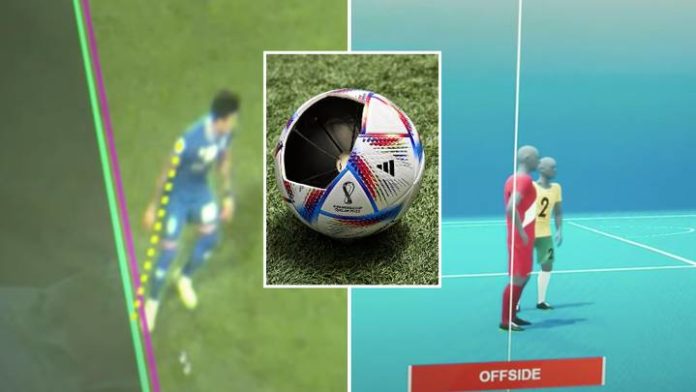Since its inception, football has been plagued by human errors that have affected results. And perhaps none have been more prominent than the dreaded ‘offside’. For years, it had been the job of the fourth official who had to decide with his own eyes in real-time to ascertain whether a player was offside or not.
And it led to several controversial decisions like Karim Benzema’s disallowed goal in the Champions League final. This first led to the Video-Assistant Referee (VAR) introduction to help the on-field referee make critical decisions. And now, the football world has gone one step further by implementing Semi-Automated offside technology.
The technology aims to quicken the time to give offside decisions. The goal is simple- ensure offsides cause as little disruption to a game as possible. Already tested for three years, the technology was used in the 2021 FIFA Arab Cup and 2021 FIFA Club World Cup. FIFA had already announced its use in the upcoming World Cup in Qatar. And UEFA has followed. The association announced that the technology will be used in the 2022-23 Champions League group stages. Before this, it was used in the UEFA Super Cup final between Real Madrid and Eintracht Frankfurt. Chelsea’s Ben Chilwell became the first player in the Champions league to be adjudged offside via Semi Automated Offside Technology.
So, what is the Semi-Automated offside technology?
What is Semi-Automated offside technology
Before diving into the technology, let’s look at its predecessor, the VAR. When it comes to offside, the VAR’s role is to check for offside during critical events such as goals. Unfortunately, while the technology is fast, it has a weak spot. The job of VAR only begins a little after the event has occurred.
The referees in the technical area then began to draw lines to check for offsides and announce their decisions. Usually, it can take more than 60 seconds. So, while it gives accurate results, it still takes time. Moreover, even though technology is used, humans are the ones operating it. Therefore, it is natural that a nature of subjectivity and opinion comes into play.
And this is where Semi-Automated offside technology enters the fray.
⚽ Michael Oliver will take charge of next week's #SuperCup match between Real Madrid and Eintracht Frankfurt in Helsinki.
The game will see a UEFA debut for Semi-Automated Offside Technology (SAOT), which will also be used as of the group stage in the upcoming #UCL season.
— UEFA (@UEFA) August 3, 2022
In this technology, 12 cameras will be placed on the roof of the stadium. The camera’s job is to track the play. These cameras will follow the ball and maintain 29 data points on all the players. These data points will be refreshed 50 times per second to ensure the most accurate position of a player.
The 29 data points will track specific parts of the body that are active. This process on all the players will be combined to check for offsides by creating a picture based on the camera’s data.
This makes the technology more accurate and faster than VAR. Also, unlike VAR, the process of checking the offside is going simultaneously with the play. And in case of an offside, the computer data will immediately create the exact scenario on the field.
Is it written in Tottenham’s destiny? All you need to know about Spurs-bound fullback Destiny Udogie
However, the process will not be entirely automated as suggested by the name semi-automated. The image will then be sent to the technical area, where the human eyes will take a call based on the image. To make the system even more foolproof, FIFA have gone a step further. The ball at the World Cup named Al Rihla will also play a crucial role.
The ball will be equipped with a sensor which will send data to the technical area 500 times per second. The data will show the position of the ball and the exact position. It will also show the precise time and place where the ball was hit, an essential part of checking offsides.
Semi-Automated offside technology future
The use of semi-Automated offside technology shows us a future where the role of technology is bound to increase. The technology could become as controversial as the VAR was at the start of the 2017-18 Premier League as people officials come to terms with it.
Here's the key 3D animation for the Semi-Automated Offside Technology which will be used in the Champions League.
Interesting…
pic.twitter.com/jpyr7YHz7u— Theo (@Thogden) August 3, 2022
However, the technology will move forward just like the VAR. After the FIFA World Cup and Champions League, the next step will be to introduce it in the top domestic leagues. From there on, it might filter down to more minor leagues and secondary competitions such as Europa League and Conference League.
Speedy Gonzales: Check out Athletic Bilbao’s pacey attacker Nico Williams who is making waves in La Liga
After some years, this next stop will be to fully convert it into an automated process with minimal human interference. In some decades, we could look at the end of fourth officials.
However, for now, the Semi-Automated offside is just a small but significant step for making football decisions better and faster.




